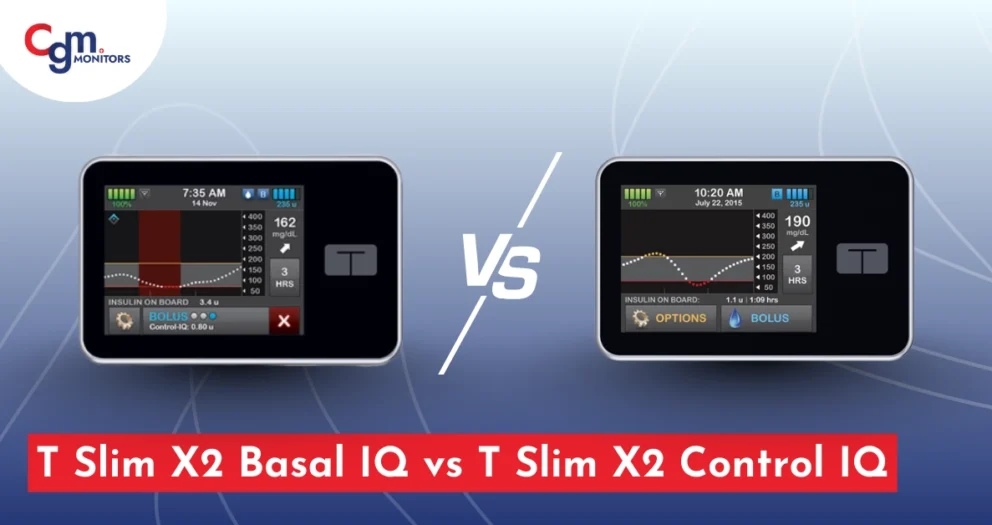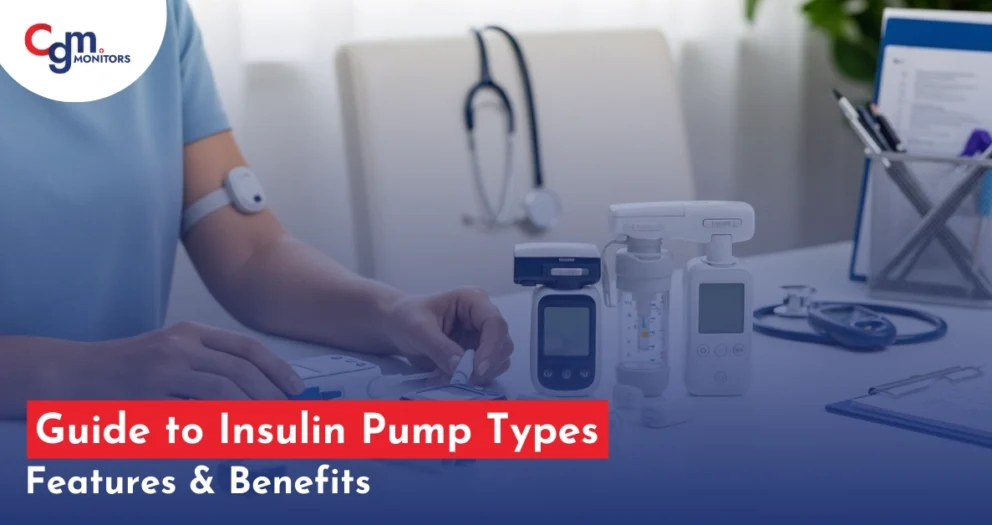Table of content
“If you want to buy a tubed or tubeless insulin pump, here is detailed information on the Tubed vs. Tubeless Insulin Pump.”
What are insulin pumps?
People who are living with diabetes and require insulin therapy used to inject insulin numerous times a day, as per their condition and body requirements obviously.
This not only has been difficult in terms of multiple pins throughout the day but this was sort of limiting people with diabetes. Insulin pumps are designed to save people from these multiple pricks, instead one cannula, with or without a tube, is attached to manage your insulin therapy with ease – supporting your active lifestyle obviously.
Tubed Insulin Pumps:
These pumps use tubing (usually available in various lengths) to deliver insulin from a reservoir to a small cannula inserted under your skin. The pump device can be clipped onto your belt or carried in a pocket. Tubed pumps offer precise insulin delivery and advanced features but require careful management of the tubing (catheter).
Example: Medtronic 770G, a semi-automated insulin delivery system that can help streamline your diabetes management. The system can function as a standalone insulin pump without the need for a Continuous Glucose Monitoring (CGM) sensor. However, to fully access advanced features like automated insulin delivery (including automatic basal insulin adjustments and predictive high/low glucose alerts), integration with a compatible CGM sensor is required. The Medtronic 750G is compatible with the Guardian Sensor 3. This insulin delivery system is controlled via the CareLink mobile app Android, the CareLink mobile app Apple, or a separate transmitter, offering enhanced connectivity and remote monitoring. This AID system is indicated for people with type 1 diabetes, 7 years of age and older.
Advantages of Tubed Insulin Pumps
Precise Customization: Tubed pumps provide extensive programming options for insulin delivery, including basal rates and doses. They are suitable for users requiring highly individualized control over their diabetes management.
Larger Insulin Reservoirs: Most tubed pumps can hold more insulin, thus reducing the need for frequent refills. This makes them ideal for individuals with higher insulin needs.
Integration with CGMs: Tubed pumps often integrate seamlessly with Continuous Glucose Monitors (CGMs), creating a closed-loop system that mimics the pancreas.
Longer Wear Time: Tubed pumps may not need to be changed as frequently as tubeless systems, offering greater convenience for some users.
Drawbacks of Tubed Insulin Pumps
Visible Tubing: The tubing can be awkward, potentially getting caught on objects or making users feel self-conscious.
Restricted Movement: Activities like swimming or exercising may require adjustments to prevent tubing issues.
Portability Challenges: The need to carry the pump on your body at all times may feel restrictive to some users.
Tubeless Insulin Pumps: Tubeless pumps, often called patch pumps, deliver insulin directly from a wearable pod adhered to the skin. These pumps are controlled remotely, usually via a separate device or smartphone app. They eliminate the need for tubing, offering greater freedom of movement.
Example: Omnipod Dash, a tubeless and waterproof insulin delivery system that is light on your pocket and can technically function as a standalone insulin pump without a Continuous Glucose Monitoring (CGM) sensor. However, to access advanced features like automated insulin delivery (including automatic bolus adjustments and predictive low glucose alerts), integration with a compatible CGM sensor is required. The Omnipod Dash is compatible with Dexcom G6, Dexcom G7, and Freestyle Libre 2 Plus sensors – you may check out these CGM sensors here. This automatic insulin delivery system is controlled with either an Omnipod 5 controller or a compatible smartphone. This AID system is indicated for people with type 1 diabetes, 2 years of age and older.
Advantages of Tubeless Insulin Pumps
Freedom from Tubing: The absence of tubing allows for more natural movement, making it easier to engage in activities like sports or swimming.
Discreet Design: Tubeless pumps are compact and less noticeable, appealing to individuals seeking a more private insulin delivery method.
Ease of Use: With fewer components, tubeless systems can be simpler to set up and maintain.
Water Resistance: Many tubeless pumps, such as Omnipod Dash, are water-resistant, offering convenience during activities like showering or swimming.
Drawbacks of Tubeless Insulin Pumps
Smaller Insulin Reservoirs: Tubeless pumps hold less insulin, requiring more frequent changes for users with higher insulin needs.
Adhesive Sensitivities: Although unusual, users may still experience skin irritation from the adhesive used to attach the pod to the skin.
Battery Dependence: Pods rely on internal batteries, which can add to the overall cost and require regular replacements.
Ranging from $749 to $9,999, a variety of Tubed and Tubeless insulin pumps can be found here. Ordering your diabetic supplies from CGM Monitors can get you competitive pricing, doorstep delivery at no extra cost (within the USA), and an auto re-ordering option.
Key Considerations for Choosing Tubed Insulin Pump VS Tubeless
Lifestyle Needs:
Active individuals or those who prioritize discreet insulin delivery may prefer tubeless pumps.
Those requiring advanced programming or higher insulin capacity might opt for a tubed pump.
Cost:
Tubeless systems may have higher ongoing costs due to frequent pod replacements, while tubed pumps may have a higher upfront cost but lower maintenance expenses.
Comfort and Convenience:
Users with adhesive sensitivities may lean toward tubed pumps, while those annoyed by tubing may prefer tubeless.
Integration with CGMs:
If you’re considering a pump that integrates with a CGM, please check compatibility first.
Final Thoughts on Tubed Insulin Pump VS Tubeless
The choice between a tubed insulin pump and a tubeless insulin pump ultimately depends on your medical needs, lifestyle, and personal preferences. Both types are effective tools for managing diabetes, but understanding their differences can help you find the best fit. Consulting with your healthcare provider is essential to ensure you select the pump that not only aligns with your health goals, but is also indicated for your diabetes type, and age.
Comparison of Tubed Insulin Pump VS Tubeless
| Feature | Tubed Insulin Pumps | Tubeless Pumps |
|---|---|---|
| How it works | Reservoir of insulin connected to a thin tube (catheter) inserted under the skin | Small, adhesive device that adheres directly to the skin and delivers insulin through a cannula |
| Pros | – More control – ideal for those who want highly programmable AID device – Typically carries more insulin in the cartridge – less changings – Easily disconnected |
– Zero tubing makes you feel like you are wearing an insulin pump – More discreet – Less worry of tube kinking and has better appearance |
| Cons | – Tubing can sometimes be difficult to manage – Risk of kinks or dislodging – May look a bit awkward to some |
– Lesser programming control than the tubed ones – The tubeless nature may require batteries costing more in the longer run |
| Lifestyle | Suitable for everyone, however it may not be the best option for athletes | Suitable for everyone, even the athletes can wear it without having to think about the tube |
| Insulin Needs | Bigger insulin cartridges and higher programming control accommodates all insulin needs | May have limitations on insulin capacity |







Where does the tube/monitor go at night during sleep?
Hello Kristi. Some individuals using short tubes prefer wearing tubed pumps around waist so they can sleep easily with it. While long tube users can place the pump beside their bed. And the tubeless pump users don’t really need to do anything specific to sleep with their pump on.
Tip: If you are a side sleeper, try wearing your pump on the opposite side.
Hope it helps!